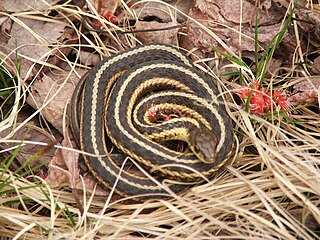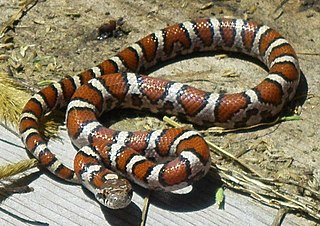
Garter snake is a common name for generally harmless, small to medium-sized snakes belonging to the genus Thamnophis in the family Colubridae. Native to North and Central America, species in the genus Thamnophis can be found from the subarctic plains of Canada to Costa Rica.

Tropidoclonion is a genus of snake in the subfamily Natricinae of the family Colubridae. The genus is monotypic, containing the sole species Tropidoclonion lineatum, commonly known as the lined snake. The species is endemic to North America.

Cemophora coccinea, commonly known as the scarlet snake, is a species of nonvenomous snake in the family Colubridae. The species is native to the southeastern United States. There are two subspecies of C. coccinea that are recognized as being valid. The Texas scarlet snake was previously considered a subspecies.

Thamnophis saurita, also known as the eastern ribbon snake, common ribbon snake, or simply ribbon snake, is a common species of garter snake native to Eastern North America. It is a non-venomous species of snake in the subfamily Natricinae of the family Colubridae. The ribbon snake averages 16 to 35 inches in total length. It is dark brown with bright yellow stripes. The ribbon snake is not sexually dimorphic; however, females are normally thicker than their male counterparts.

The Texas garter snake is a subspecies of the common garter snake. The subspecies, which belongs to the subfamily Natricinae of the family Colubridae, is native to the western United States.

Thamnophis proximus rubrilineatus, the redstripe ribbon snake, is a subspecies of the western ribbon snake, a garter snake endemic to the southern United States.

Hypsiglena jani, commonly known as the Texas night snake or the Chihuahuan night snake, is a small species of mildly venomous snake in the family Colubridae. The species is native to the southwestern United States and adjacent northeastern Mexico.
The Texas scarlet snake is a species of nonvenomous snake in the family Colubridae. The species is endemic to the South Central United States. It was previously considered a subspecies of Cemophora coccinea.

The Texas lyre snake is a species of mildly venomous, rear-fanged snake in the family Colubridae. The species is endemic to the southwestern United States and adjacent northern Mexico.

The checkered garter snake is a species of garter snake in the subfamily Natricinae of the family Colubridae. The species is endemic to the southwestern United States, Mexico, and Central America.

Storeria dekayi, commonly known as De Kay's brown snake, De Kay's snake, and simply the brown snake, is a small non-venomous species of snake in the family Colubridae. The species is native to North America and Central America.

Thamnophis saurita saurita, the eastern ribbon snake or common ribbon snake, is one of four subspecies of the ribbon snake found in the southeastern United States.

Butler's garter snake is a species of garter snake in the family Colubridae. The species is endemic to North America.

The crayfish snake, also known commonly as the glossy crayfish snake, the glossy swampsnake, the glossy water snake, and the striped water snake, is a species of semiaquatic snake in the subfamily Natricinae of the family Colubridae. The species is endemic to the southeastern United States, and preys mainly on crayfish.

Heterodon simus, commonly known as the southern hog-nosed snake, is a harmless snake species endemic to the southeastern United States. No subspecies are currently recognized.

Lampropeltis getula, commonly known as the eastern kingsnake, common kingsnake, or chain kingsnake, is a harmless colubrid species endemic to the United States and Mexico. It has long been a favorite among collectors. Nine subspecies are currently recognized, including the nominate subspecies described here.

Thamnophis proximus, commonly known as the western ribbon snake, is a species of garter snake in the subfamily Natricinae of the family Colubridae. The species is endemic to the western United States, Mexico, and Central America. The species has six recognized subspecies.

The common watersnake is a species of large, nonvenomous, common snake in the family Colubridae. The species is native to North America. It is frequently mistaken for the venomous cottonmouth.

The midwestern worm snake, Carphophis amoenus helenae, a subspecies of C. amoenus, is a nonvenomous snake in the family Colubridae. The subspecies is endemic to the Midwest and Southern United States.

Lampropeltis triangulum triangulum, commonly known as the eastern milk snake or eastern milksnake, is a subspecies of the milk snake. The nonvenomous, colubrid snake is indigenous to eastern and central North America.



















